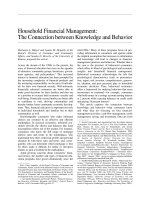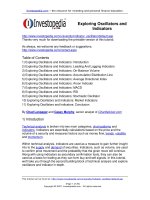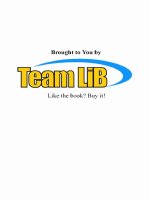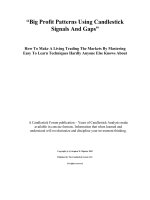Plant Assets and Intangibles doc
Bạn đang xem bản rút gọn của tài liệu. Xem và tải ngay bản đầy đủ của tài liệu tại đây (166.63 KB, 48 trang )
Plant Assets and Intangibles
Chapter 10
Asset Account on Related Expense Account
the Balance Sheet on the Income Statement
Plant Assets
Land……………………………… none
Buildings, Machinery and
Equipment, Furniture
and Fixtures, and Land
Improvements………….… Depreciation
Natural Resources……… …… Depletion
Intangibles………………………. Amortization
Plant Assets
Measure the
cost
of a plant asset.
Objective 1
An asset must be carried on the
balance sheet at the amount paid for it.
The cost of an asset equals the sum of
all of the costs incurred to bring the asset
to its intended purpose, net of discounts
Cost Principle
Land and Land Improvements
Purchase price of land $500,000
Add related costs:
Back property taxes $40,000
Transfer taxes 8,000
Removal of buildings 5,000
Survey fees 1,000 54,000
Total cost of land $554,000
Paving
Fences
Sprinkler systems
Lights in parking lot
Land Improvements
•
All improvements located on the land but
subject to decay:
Buildings – Construction
Architectural fees
Building permits
Contractor’s charges
Materials
Labor
Overhead
Buildings – Purchasing
Purchase price
Brokerage commissions
Sales and other taxes
Repairing or renovating building
for its intended purpose
Machinery and Equipment
Purchase price less discounts
Transportation charges
Insurance in transit
Sales and other taxes
Purchase commissions
Installation cost
Expenditures to test asset
before it is placed in service
Lump-Sum Purchases Example
•
Andrea Ortiz paid $110,000 for a
combined purchase of land and a building.
•
The land is appraised at $90,000 and the
building at $60,000.
•
How much of the purchase price is
allocated to land and how much to the
building?
Lump-Sum Purchases Example
Building: $60,000 ÷ $150,000 = 40%
$110,000 × 40% = $44,000
Building: $60,000 ÷ $150,000 = 40%
$110,000 × 40% = $44,000
Land: $90,000 ÷ $150,000 = 60%
$110,000 × 60% = $66,000
Land: $90,000 ÷ $150,000 = 60%
$110,000 × 60% = $66,000
Does the expenditure increase capacity
or efficiency or extend useful life?
YES NO
Capital Expenditure
Debit Plant Assets
accounts
Revenue Expenditure
Debit Repairs and
Maintenance account
Distinction Between Capital and
Revenue Expenditures
Cost or basis
Estimated residual value
Estimated useful life
Measuring the Depreciation
of Plant Assets
Objective 2
Account for
depreciation.
Straight-Line (SL)
Straight-Line (SL)
Units-of-Production (UOP)
Units-of-Production (UOP)
Double-Declining-Balance (DDB)
Double-Declining-Balance (DDB)
Depreciation Methods
Depreciation Methods Example
•
Donishia and Richard Catering, Inc.,
purchased a delivery van on January 1,
200x, for $22,000.
•
The company expects the van to have a
trade-in value of $2,000 at the end of its
useful life.
•
The van has an estimated service life of
100,000 miles or 4 years.
(Cost – Residual value) ÷ years of useful life
($22,000 – 2,000) ÷ 4 = $20,000 ÷ 4 = $5,000
Year 1 Depreciation: $ 5,000
Year 2 Depreciation: 5,000
Year 3 Depreciation: 5,000
Year 4 Depreciation: 5,000
Total Depreciation: $20,000
Straight-Line Method Example
($22,000 – 2,000) ÷ 100,000 = $.20/mile
Year 1: 30,000 miles = $ 6,000
Year 2: 27,000 miles = 5,400
Year 3: 23,000 miles = 4,600
Year 4: 20,000 miles = 4,000
Total: 100,000 miles = $20,000
(Actual mileage in year 4 was 22,000)
Units-of-Production
Method Example
Double-Declining-Balance
Method Example
•
Straight-line rate is 100% ÷ 4 = 25%
•
Double-declining-balance = 2 times the
straight-line rate = 50%
•
What is the book value of the van at the
end of the first year?
•
$22,000 × 50% = $11,000
•
$22,000 – $11,000 = $11,000
Double-Declining-Balance
Method Example
Dec. 31, 200x
Depreciation Expense $11,000
Accumulated Depreciation $11,000
To record depreciation expense for a one-year
period
Depreciation Methods
Comparison
Year SL UOP DDB
1 $ 5,000 $ 6,000 $11,000
2 $ 5,000 $ 5,400 $ 5,500
3 $ 5,000 $ 4,600 $ 2,750
4 $ 5,000 $ 4,000 $ 750
Totals $20,000 $20,000 $20,000
Use of Depreciation Methods
82%
8%
5%
3%
2%
Straight-line
Accelerated –
(not specified)
UOP
Declining-
balance
Other
Objective 3
Select the best
depreciation
method for tax purposes.
Relationship Between
Depreciation and Taxes
•
MACRS was created by the Tax Reform
Act of 1986.
•
It is an accelerated method used for
depreciating equipment.
Straight-line method:
$5,000 × 3/12 = $1,250
Double-declining-balance method:
$11,000 × 3/12 = $2,750
Depreciation for Partial Years
•
Assume that Donishia and Richard
Catering, Inc., owned the van for 3
months.
•
How much is the van’s depreciation?









